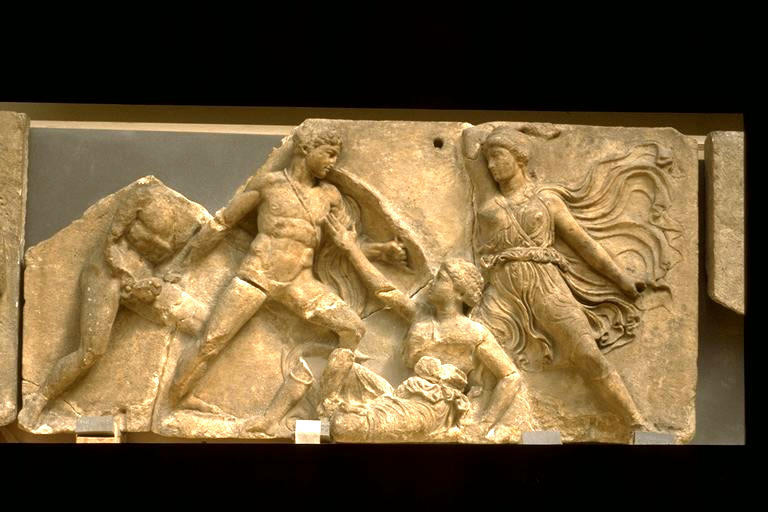The temple worshiped Apollo at Bassae
Unesco's Scientific, Educational and Cultural Organization recognized the Temple of Apollo in Bassae as a World Cultural Heritage in 1986.
The temple of Apollo is an ancient Greek temple in Bassae and was built around the middle of the 5th century BC. Although this temple is located far from important cities of ancient Greece, it is most studied because of its unusual architectural features.

Located in the remote mountainous area of Peloponnese, Apollo's full name Apollo Epicurius in Bassae is one of the world's largest and well-preserved ancient temples.
The temple is located at 1,131 meters above sea level, surrounded by many narrow streams, 14.5 km from Andritsaina town. The isolated location and the special meaning of the temple are the research topics of scientists for 2 centuries. It is hypothesized that the villagers around here worshiped Apollo for protecting them so they built this temple (from Epicurius meaning helpers and guardians). There is also a hypothesis that they build their own money on the temple to hope that Apollo will protect them.

In Greek mythology, Apollo is very famous.Apollo is the god of light, truth and art , often expressed in the form of a blond boy, wearing a silver bow and wearing a lyre. The god of Zeus and the goddess Leto, is the twin brother of the hunting goddess Artemis. Apollo is often known for its long-range name shooting. Apollo is often identified with Helios.

This shrine has a very special architecture, a combination of Doric, Lonic and Corinth architectures . In fact, Corinth-style decorative pillars here are the oldest in the world. Built simply by gray honeycomb stone, inspired by the wind blowing all year round, the temple has a sad and cold look. Especially in the temple, the statues and stone pillars are made from extremely gorgeous marble. These pillars are currently on display in the British Museum.
While the outside of the shrine is designed with Doric architecture, inside the temple represents an incredible combination of Lonic and Corin architecture. The combination of 10 columns of Ionic architecture in the lowlands and a Corinth-style pillar at the southern end of the temple creates a great attraction for this Greek architecture. There is a pity that these thousands of stone columns have been more or less damaged.
 The stone pillars designed in Donric style at the Apollo temple were preserved quite well, so even though it has been for thousands of years, it is still relatively intact.
The stone pillars designed in Donric style at the Apollo temple were preserved quite well, so even though it has been for thousands of years, it is still relatively intact.
Outside the temple are 15 Donric pillars designed along the length of the temple and 6 columns horizontally. Most of them still retain their original designs.
In 1986, the temple was recognized as a world heritage by Unesco and the first recognized heritage in Greece. Since then, plans to restore the temple are still being carried out continuously every year.

The Temple of Apollo at Bassae has been built with an extremely meticulous, creative and beautiful blend of many different ancient architecture. It was because of this isolated position that the temple was well protected over the years of time. Traces of landslides were only found in 1765 when the French architect Joachim Bocher accidentally discovered. The Greek Archaeological Association restored the temple from 1902 to 1906, replacing the broken pillars and repairing the inner walls. Another remodeling was carried out in the 1960s when debris from brick pillars was dug up. In 1987, the Greek government decided to cover the entire temple with a cloth specially designed to protect the temple from the effects of weather and climate.


Not only is a beautiful, unique architecture, the Temple of Apollo also contains a history of thousands of years of Greece and the origins of myths about Greek gods. Therefore, this heritage is of special interest and despite many exploration and archeology, but according to scientists, historians and archaeologists, this place still contains many secrets. decoded.

 Some of the statues, carvings and photographs of the Temple of Apollo are preserved and preserved at the museum.
Some of the statues, carvings and photographs of the Temple of Apollo are preserved and preserved at the museum.
- Recreate the first temple of Rome by digital
- Delphi Square (Greece)
- The secret to Neil Armstrong and Apollo 11 almost died when he returned to Earth
- The heroes were silent in the Apollo 13 disaster
- Mystery of temples 'timeless' in India: There is a value of up to 100 billion USD!
- Learn about the Apollo program - America's Moon-lift program
- NASA first announced tens of thousands of hours of recording of the Apollo 11 mission to the Moon
- Those who sacrifice for the success of the Apollo program
- Video: Apollo mission through short film
- NASA's confusing action when destroying hundreds of tapes from the Apollo era
- Why do humans worship serpent?
- Snake and custom of worship of Vietnamese people
 Suzhou classic bonsai garden - China
Suzhou classic bonsai garden - China Chau Nguyen Dynasty
Chau Nguyen Dynasty Thai Son Mountain - World Wonder
Thai Son Mountain - World Wonder Ancient villages of Shirakawa-go and Gokayama
Ancient villages of Shirakawa-go and Gokayama